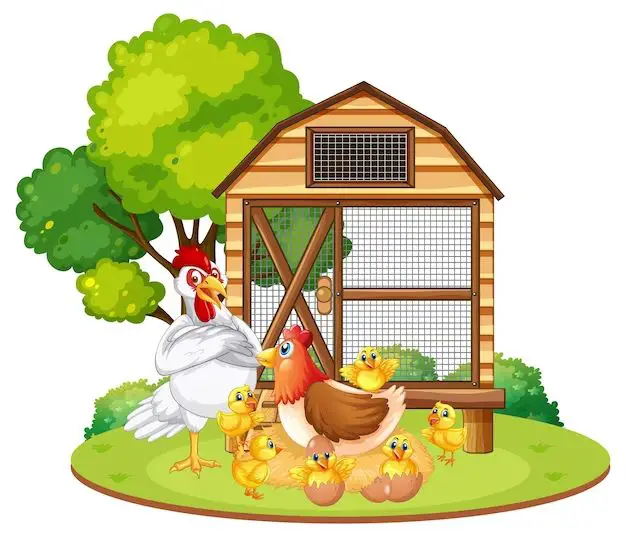Raising backyard chickens is becoming an increasingly popular hobby. Chicken coops provide a safe and comfortable home for chickens while allowing easy access for the caretaker. When building or buying a chicken coop, it’s important to consider factors like climate, number of chickens, and available space. Three popular styles of chicken coops are:
Page Contents
1. A-Frame Chicken Coop
An A-frame chicken coop features a triangular frame that slopes downwards on both sides from a central peak, resembling the letter ‘A’. This style provides plenty of interior space while a smaller footprint than a rectangular coop.
Key features of A-frame coops:
- Roomy interior with nesting boxes and perches on both sides of the central peak
- Sloped roof allows rain and snow to easily slide off
- Well-ventilated through windows, doors, and roof vents
- Usually 4-8 feet wide and 4-6 feet tall. Length can vary.
The sloped walls provide ample headroom inside. Nesting boxes are often built into one or both of the slanted walls. The roof overhang provides shade and protection from the elements while a fenced outdoor run lets the chickens roam safely.
A-frame coops are a good choice for small to mid-sized flocks in areas with cold winters. The sloped roof helps shed rain and snow. Just be sure to allow proper ventilation during hot summer months.
2. Cube-Style Chicken Coop
As the name suggests, cube coops are square or rectangular in shape like a cube. This makes them simple to construct and provides straight walls for an efficient use of space.
Key features of cube coops:
- Rectangular coop with vertical walls and flat or slightly sloped roof
- Nesting boxes built into the walls or lining one wall
- Usually 4-8 feet wide and tall. Length depends on flock size.
- Often raised up on legs or built on a platform
The cube design provides plenty of headroom and makes it easy to add nest boxes, perches, feeders and other elements needed for chicken keeping. A basic cube coop contains a henhouse for roosting and laying eggs. An attached outdoor run offers secure access to the ground and fresh air.
Ventilation and protection from the hot sun are important considerations for cube coops in warm climates. Floors should be raised above the ground and windows screened to keep out rodents.
Cube coops work well for both small backyard flocks and larger coops holding 20 or more chickens. Their simple shape makes them an approachable beginner project for home construction.
3. Chicken Tractor Coop
Chicken tractors consist of a portable coop and fenced run that can be moved around the yard to provide fresh pasture for the flock. Lightweight tractors can be pulled by hand while larger ones require a tractor or other vehicle for towing.
Key features of chicken tractors:
- Built on a floorless platform or skids for easy moving
- Henhouse and run combined in one portable structure
- Often uses lightweight canvas, plastic or wood slat sides that allow sunlight
- Provides fresh forage and helps fertilize the yard
Chicken tractors allow birds to graze freely on grass and insects while protecting them from predators. The tractor gets moved to a new patch of yard every few days once the flock has stripped the vegetation and fertilized the ground. Popular for pastured poultry operations.
Frequent moves can be labor intensive depending on the tractor design. Precautions must also be taken to avoid predators digging under the edges and fencing should be secured from digging chickens.
Chicken tractors work best with a smaller flock size of 5-12 chickens. They provide free range benefits while keeping birds safe and contained. Best suited for flat or gently sloping yards that are free of digging predators.
Choosing the Right Chicken Coop
When deciding on a chicken coop, here are some key considerations:
- Climate – Choose a coop style suited to your weather and temperatures. Well-ventilated for hot areas, insulated for cold winters.
- Flock size – Plan a coop size that provides at least 3-4 square feet per chicken inside.
- Materials – Durability and ease of cleaning are important. Pressure treated wood, molded plastic or treated plywood work well.
- Predators – Fortify against local predators like raccoons, foxes or neighborhood dogs. Hardware cloth instead of chicken wire.
- Ease of access – Doors and feeders positioned for convenient feeding and cleaning. People doors to avoid stooping inside.
Additional elements like electricity, running water or egg collection systems may be worth investments for increased convenience and production.
Here is a comparison of the three coop styles:
| Coop Style | Flock Size | Climates | Maintenance |
|---|---|---|---|
| A-Frame | Small to Medium | Cool Temperate | Low |
| Cube | Small to Large | All Climates | Low |
| Chicken Tractor | Small | All Except Deep Snow | High |
Conclusion
Chicken coops come in many styles but A-frames, cubes and tractors are three popular options. The best choice depends on your specific needs and situation. Careful planning will lead to happy, productive chickens and a coop that suits your backyard flock.
With basic carpentry skills and chicken know-how, you can build a custom coop adapted for your climate and chickens. Pre-made coops are also available that provide an easy solution. Add a fenced run and coop accessories to complete your perfect chicken-keeping setup.
Raising backyard chickens is an enjoyable and rewarding hobby. Choose a coop style that provides the right environment for your flock to thrive. Then watch your chickens relax, forage and produce delicious fresh eggs every day!
